The modern corporation operates in a dynamic environment where the biggest threats—from cyber breaches to supply chain disruption—can emerge from the smallest, least expected corners.
- The Problem: Strategic risk plans crafted by leadership often fall short, missing the vital, small, daily operational risks. Executives can chart the course, but often enough they don’t see the icebergs lurking just beneath the surface of day-to-day operations.
- The Solution: True risk mitigation demands a cultural shift, moving beyond a simple compliance checklist to a system where every employee is trained and empowered to be the “first line of defense.” Effective corporate risk management training is the essential bridge, linking the executive suite’s strategic vision to the day-to-day reality on the ground.
All Employees Need Corporate Risk Management Training
An organization is only as strong as its weakest link, and often, that link is an untrained employee facing a novel risk.
Employees with better risk awareness are better prepared to handle everyday risks and make smart, on-the-spot decisions. When they understand the company’s risk tolerance, they can stop a “near miss” from becoming a catastrophic failure.
Training leads to faster, more informed choices at the point of action. An employee who recognizes a strange IT request or a non-compliant process doesn’t need to wait for a supervisor; they have the agency to flag or halt it immediately.
Empowered vigilance reduces costs and increases efficiency by minimizing mistakes, preventing minor operational incidents from escalating, and drastically reducing the cost of recovery from a major event.
Addressing the Executive-Level Blind Spot
The separation of the executive suite from operational reality creates significant risk blind spots. For example, operational failures, process issues, minor compliance slips, and even toxic team dynamics often go unnoticed by management.
As John McLaughlin, Founder of ERM Exchange, has emphasized in his work on risk culture, employees are closest to the action and can detect these “near misses” and emerging threats immediately. Their visibility is the organization’s greatest intelligence asset.
It is critically important to eliminate the hesitation, fear, or blame culture that stops employees from reporting potential issues. No employee should have to choose between saving the company from a risk versus saving their own job by remaining silent.
Building a “Speak-Up” Risk Culture
According to ERM best practices, risk culture is one of the five interrelated components of a robust Enterprise Risk Management program. A strong culture ensures the flow of risk information upward.

1. Establish Trust
The first step is to establish trust, not blame. Leadership must establish an environment where reporting a potential risk is viewed as an act of loyalty and courage, not a reason for punishment or blame. This shift is what transforms employees from liabilities into assets.
2. Provide Clear Channels
Second, employees need clear, accessible, and often safe and anonymous channels to report emerging risks. If the process is cumbersome or vague, the risk will remain unreported and fester.
3. Leadership Action
Leadership must acknowledge and visibly act on employee-raised risks to maintain trust and embed the new culture. If a reported issue disappears into a black hole, the culture of silence and cynicism will quickly return.
How Training Strengthens Management’s Abilities
Once the new risk management reporting process is in place and the risk tolerance is set, employees need to be trained on the changes. Corporate risk management training is not just for the staff; it provides vital ground-level intelligence that fundamentally improves executive decision-making.
Training links the organization’s high-level risks and response strategies directly to the company’s strategic plan. Employees learn why their actions matter to the strategic success of the enterprise.
Empowered employees are often the first to identify risk strategies that are insufficient—for instance, questionable business practices, a fraud prevention control that is easily bypassed, a broken internal process, or outdated technology that invites cyber risk.
By providing ground-level intelligence, the training program ultimately enhances management’s ability to generate greater enterprise value. It helps management de-risk decisively and scale instantly by ensuring that growth initiatives have been vetted by the people who execute them every day.
ERM Training: A Cultural Imperative
Successful risk management is not a compliance checklist or a document that lives on a shared drive; it’s a shared, vigilant culture. As management consultant Peter Drucker famously said, “Culture eats strategy for breakfast,” and in risk management, a better culture improves strategic outcomes.
The ultimate goal of corporate risk management training is to ignite that culture of empowered, proactive risk sensing across all levels of the organization.
Drive Value from the Ground Up. Ready to transform your employees into your organization’s greatest risk mitigation asset?
Discover how ERM Exchange’s tailored Risk Management Training programs can embed a “speak-up” culture, connect day-to-day operations to your strategic objectives, and enhance your overall enterprise value.
